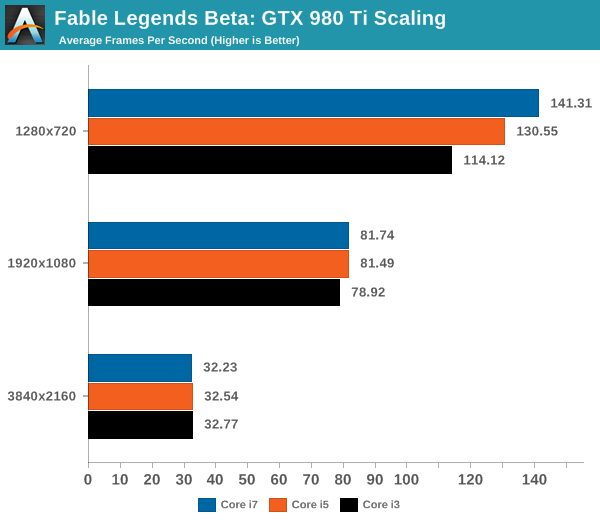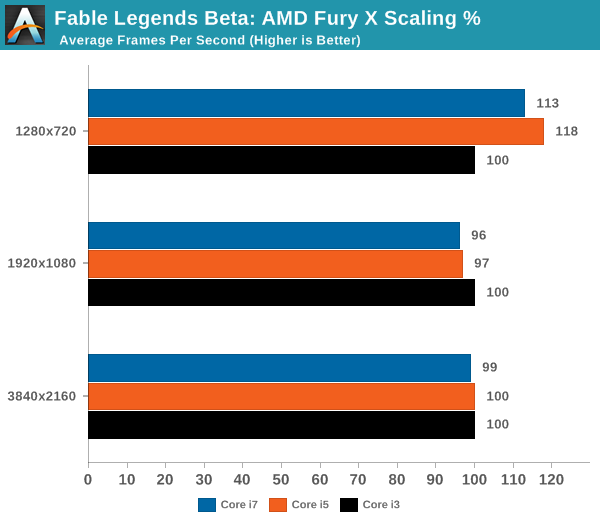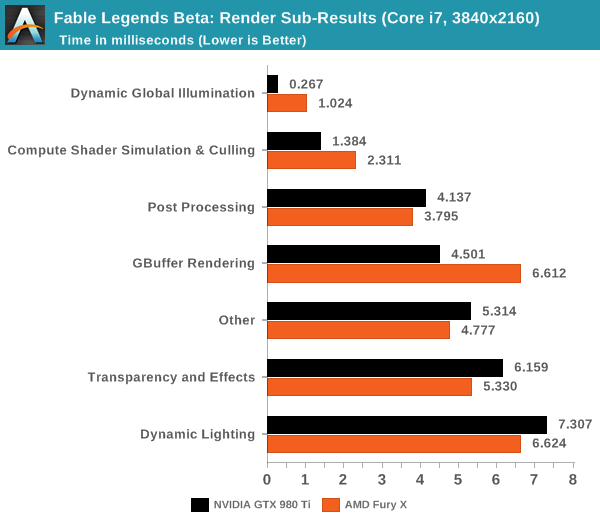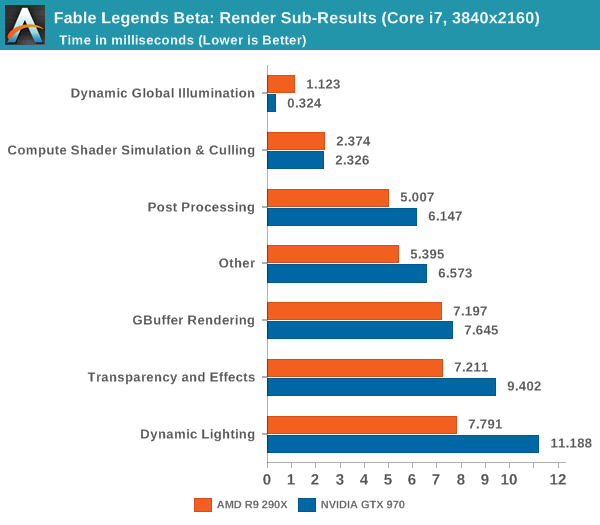Fable Legends Early Preview: DirectX 12 Benchmark Analysis
by Ryan Smith, Ian Cutress & Daniel Williams on September 24, 2015 9:00 AM ESTCPU Scaling
When it comes to how well a game scales with a processor, DirectX 12 is somewhat of a mixed bag. This is due to two reasons – it allows GPU commands to be issued by each CPU core, therefore removing the single core performance limit that hindered a number of DX11 titles and aiding configurations with fewer core counts or lower clock speeds. On the other side of the coin is that it because it allows all the threads in a system to issue commands, it can pile on the work during heavy scenes, moving the cliff edge for high powered cards further down the line or making the visual effects at the high end very impressive, which is perhaps something benchmarking like this won’t capture.
For our CPU scaling tests, we took the two high end cards tested and placed them in each of our Core i7 (6C/12T), Core i5 (4C/4T) and Core i3 (2C/4T) environments, at three different resolution/setting configurations similar to the previous page, and recorded the results.


Looking solely at the GTX 980 Ti to begin, and we see that for now the Fable Benchmark only scales at the low resolution and graphics quality. Moving up to 1080p or 4K sees similar performance no matter what the processor – perhaps even a slight decrease at 4K but this is well within a 2% variation.


On the Fury X, the tale is similar and yet stranger. The Fable benchmark is canned, so it should be running the same data each time – but in all three circumstances the Core i7 trails behind the Core i5. Perhaps in this instance there are too many threads on the processor contesting for bandwidth, giving some slight cache pressure (one wonders if some eDRAM might help). But again we see no real scaling improvement moving from Core i3 to Core i7 for our 1920x1080 and 3840x2160.

As we’ve seen in previous reviews, the effects of CPU scaling with regards resolution are dependent on both the CPU architecture and the GPU architecture, with each GPU manufacturer performing differently and two different models in the same silicon family also differing in scaling results. To that end, we actually see a boost at 1280x720 with the AMD 7970 and the GTX 680 when moving from the Core i3 to the Core i7.
If we look at the rendering time breakdown between GPUs on high end configurations, we get the following data. Numbers here are listed in milliseconds, so lower is better:

Looking at the 980Ti and Fury X we see that NVIDIA is significantly faster at GBuffer rendering, Dynamic Global Illumination, and Compute Shader Simulation & Culling. Meanwhile AMD pulls narrower leads in every other category including the ambiguous 'other'.

Dropping down a couple of tiers with the GTX 970 and R9 290X, we see some minor variations. The R9 290X has good leads in dynamic lighting, and 'other', with smaller leads in Compute Shader Simulation & Culling and Post Processing. The GTX 970 benefits on dynamic global illumination significantly.
What do these numbers mean? Overall it appears that NVIDIA has a strong hold on deferred rendering and global illumination and AMD has benefits with dynamic lighting and compute.










141 Comments
View All Comments
Gotpaidmuch - Thursday, September 24, 2015 - link
Sad day for all of us when even the small wins, that AMD gets, are omitted from the benchmarks.Oxford Guy - Thursday, September 24, 2015 - link
"we are waiting for a better time to test the Ashes of the Singularity benchmark"ZipSpeed - Thursday, September 24, 2015 - link
The 7970 sure has legs. Turn down the quality down one notch from ultra to high, and the card is still viable at 1080p gaming.looncraz - Thursday, September 24, 2015 - link
As a long-time multi-CPU/threaded software developer AMD's results show one thing quite clearly: they have some unwanted lock contention in their current driver.As soon as that is resolved, we should see a decent improvement for AMD.
On another note, am I the only one that noticed how much the 290X jumped compared to the rest of the lineup?!
Does that put the 390X on par with the 980 for Direct X 12? That would be an interesting development.
mr_tawan - Thursday, September 24, 2015 - link
Well even if UE4 uses DX12, it would probably just a straight port from DX11 (rather than from XBONE or other console). The approach it uses maynot flavour AMD as much as Nvidia, who know ?Also I think the Nvidia people would have involved with the engine development more than AMD (due to its developer relationships team size I guess). The Oxide games also mentioned that they got this kind of involvement as well (even if the game is AMD title).
tipoo - Thursday, September 24, 2015 - link
Nice article. Looks like i3s are going to only get *more* feasible for gaming rigs under DX12. There's still the odd title that suffers without quads though, but most console ports at least should do fine.ThomasS31 - Thursday, September 24, 2015 - link
Still not a Game performance test... nor a CPU.There is no AI... and I guess a lot more is missing that would make a difference in CPU as well.
Though yeah... kind a funny that an i3 is "faster" than an i5/7 here. :)
Traciatim - Thursday, September 24, 2015 - link
This is what I was thinking too. I thought that DX12 might shake up the old rule of thumb saying 'i5 for gaming and i7 for working' but it seems to be this still holds true. In some cases it might even make more sense budget wise to go for a high end i3 and sink as much in to your video card as possible rather than go for an i5 depending on where your budget and current expected configuration are.More CPU benchmarking and DX12 benchmarks are needed of course, but it still looks like the design of machines isn't going to change all that much.
Margalus - Friday, September 25, 2015 - link
this test shows absolutely nothing about "gaming". It is strictly rendering. When it comes to "gaming" I believe your i3 is going to drop like a rock once it has to start dealing with AI and other "gaming" features. Try playing something like StarCraft or Civilization on your i3. I don't think it's going to cut the muster in the real world.joex4444 - Thursday, September 24, 2015 - link
As far as using X79 as the test platform here goes, I'm mildly curious what sort of effect the quad channel RAM had. Particularly with Core i3, most people pair that with 2x4GB of cheap DDR3 and won't be getting even half the memory bandwidth your test platform had available.Also fun would be to switch to X99 and test the Core i7-5960X, though dropping an E5-2687W in the X79 platform (hey, it *is* supported after all).